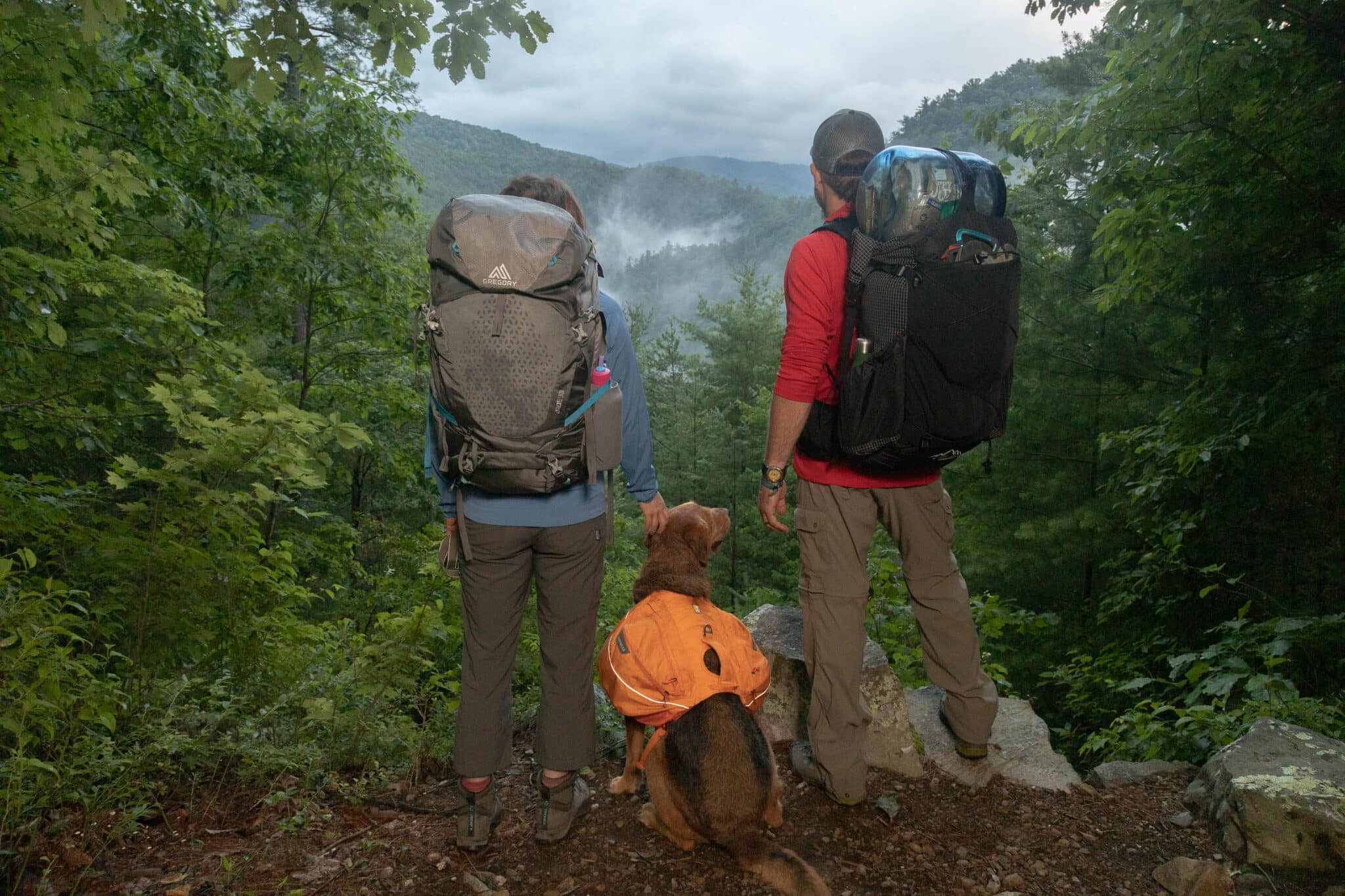Even if your favorite weather is hot and dry, backpacking in the rain can be an absolute joy!
The dust has been washed away, leaving the air fresh and the foliage at its greenest.
Water droplets smack the canopy overhead in a funky, offbeat pattern.
The earth wafts the smell of freshly moistened dirt… my personal favorite.
Obviously, I appreciate rainy-day hikes. But I’m not blind to the extra logistics the rain can bring. The upsides have equal and opposite downsides like dust being replaced with mud and increased water supply turning into an actual flood. Staying warm and dry is a big part of backcountry survival, too, and rain complicates that rather quickly.
Let’s talk about how to negate some risks and make the most of it when the forecast turns grey.
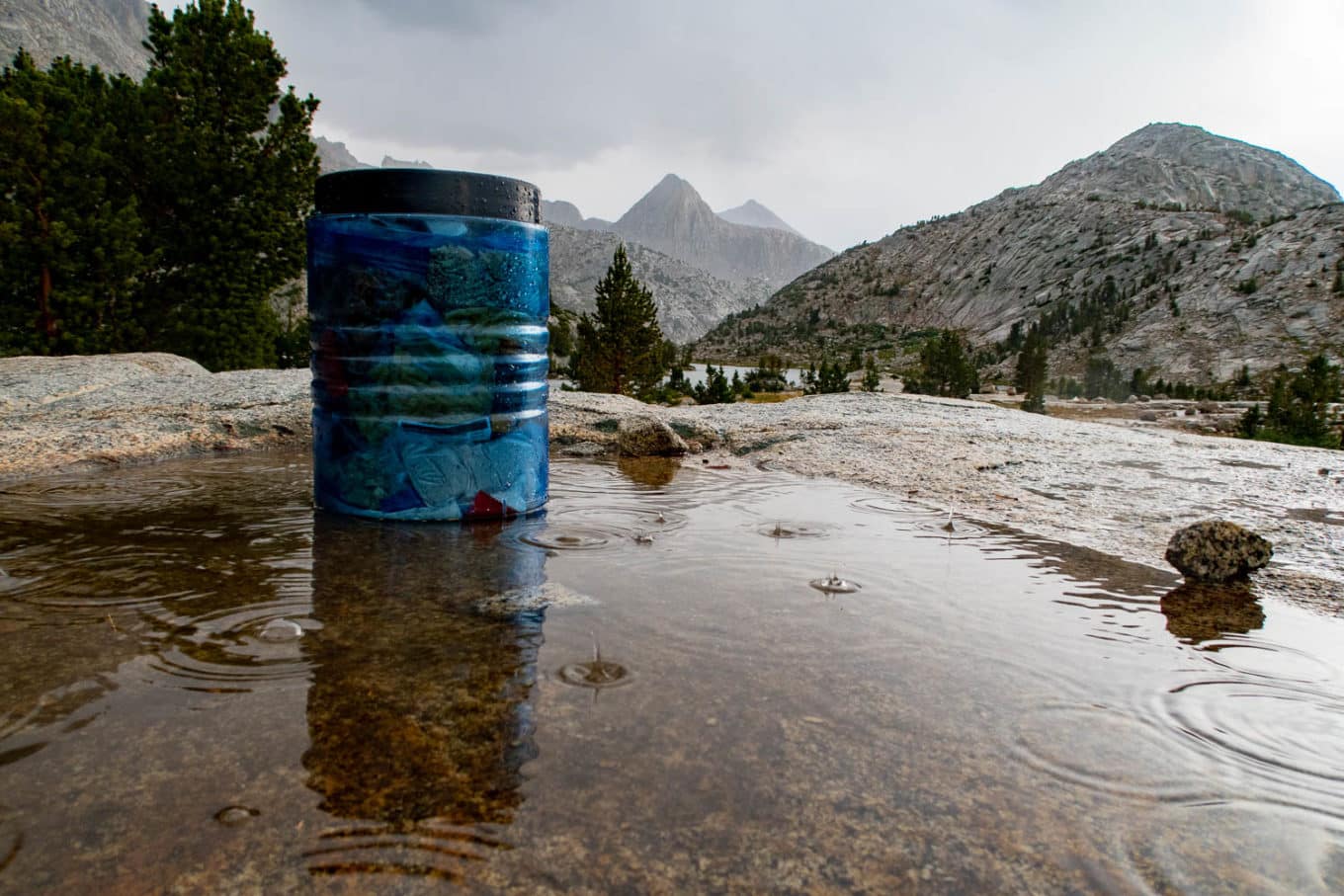
Keeping Yourself Warm
Getting wet can wreak havoc on your goal of staying warm. That’s because water on your skin is really, really good at sucking the life, er, I mean heat, out of your body. That’s really helpful when it’s hot out! You get hot – you sweat – it evaporates – you cool off… it’s a great cool-down mechanism. But when you don’t want to cool down, it sucks.
That’s why keeping yourself warm during wet weather depends largely on keeping yourself dry. The easiest way to do this is by having the right kind of gear.
Now, you can get as high-tech and expensive as you want to with this. Or, you can go old-school and use plastic bags, like I remember doing as a kid when I lost my snow boots. That’s slippery as heck, though, so I really don’t recommend it!
Here are some pieces of gear to consider when preparing for a rainy day on the trail.
- Rain Pants
- You can get anything from basic step-in plastic pants with an elastic waist to thick pants with side closures so you don’t have to slide your muddy boot through the leg.
- Rain Jacket
- Options abound, and you can choose based on weight, material, or style. Many brands offer combination coats with a zip-on rain jacket you can remove when the weather clears, but any raincoat can be thrown over your insulating layer.
- Poncho
- A great low-cost option is a backpacking poncho. These are typically lightweight and have a small footprint in your bag. They won’t cover your legs, but keeping your torso dry is the most important thing, and a poncho can do that job just fine.
- Gators and Boot Covers
- Your hiking footwear may or may not be waterproof on its own. If it’s not, you may find it well worth the extra weight to have dry feet at the end of the day. Of course, the real pay-off will be the next morning when you go to slip back into those shoes! Gators can enhance the performance of your waterproof shoes, but full covers can make any shoe come out bone dry.
That being said… you can also decide to simply chill in your shelter during a rainstorm. That would keep you dry and warm, too.
But wait, you say… what about keeping your gear dry? Backpacking kinda’ involves quite a bit of gear and no car to store it in. Let’s talk about that.
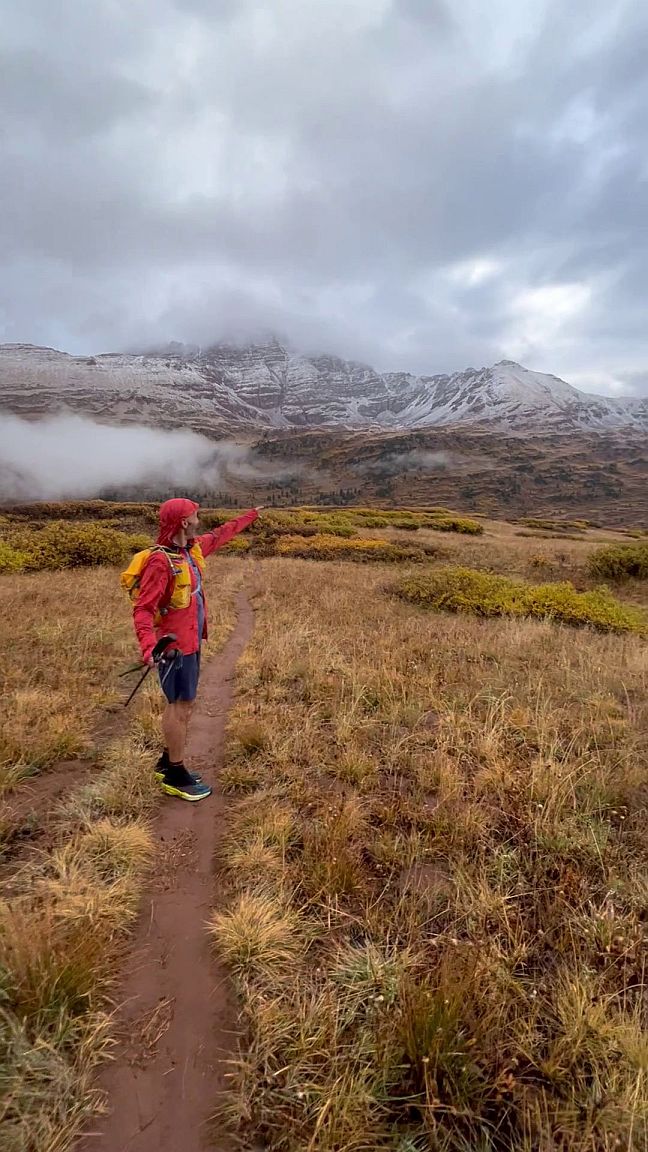
Keeping Your Gear Dry
While on the trail, keeping your pack dry simply requires using a bag cover. That likely came with your backpack, but if you bought it used or have lost it, you can go to your manufacturer’s website to find the right fit. They make covering your packed pack easy with properly placed clips and just the right amount of stretch.
Many hikers also opt to use pack liners, which are just essentially large plastic bags in your pack that everything goes inside.
You also can protect the most important items in a lightweight dry bag.
The hard part isn’t when you’re on the trail, though. It’s setting up and breaking down camp. Here are some thoughts on staying as dry as possible during that task.
1. Know Your Tent
Your tent is going to get wet… it’s exposed all night. But prioritizing high ground to avoid pooling and getting the rain fly on quickly will protect the interior. Practice setting up as quickly as possible. If you have a tent with Fast Pitch Mode, get good at using it.
2. Wait Out the Worst
Some rains are incessant, and others come and go. If you can access radar information, use it to determine when there will be a lull to set up camp. If you’re flying blind, you may find it worth the wait to see if the rain slows down for you.
3. Bring a Staging Shelter
If you have the space and know your destination, bringing an extra rain fly to stretch between trees and provide a temporary shelter during set-up can help. You can leave your gear under this while you pitch your tent. Setting it up in the right location can also make it a great way to stick to your safe food etiquette rule of cooking away from the tent.
On that last note, let’s talk about food.
Cooking in the Rain
It’s going to be super tempting to hide out in your nice, cozy tent and just listen to the patter of raindrops while you cook your supper. Dinner? Which region of the country are you from? Anyway…
But you know you can’t do that, right? It’s like Cardinal Rule number one of responsible food storage when camping in bear country: do NOT have food in your tent. So, what are you supposed to do?
Just get that raincoat back on and get away from your tent to cook.
Rain can have an impact on a bear’s ability to smell, but it may not be the impact you’re expecting. Yes, a heavy rain can wash away smells that were there before. But humidity that lingers after a shower can actually enhance the scents that come after the rain stops, especially if that air is warm. That means your chili on the stove can stand out even more than normal if the timing is right.
While we’re on the subject, don’t let the rain make you lazy on safe food storage practices. Go ahead and walk those extra 70 steps to get your food away from where you’re going to lay your head tonight.
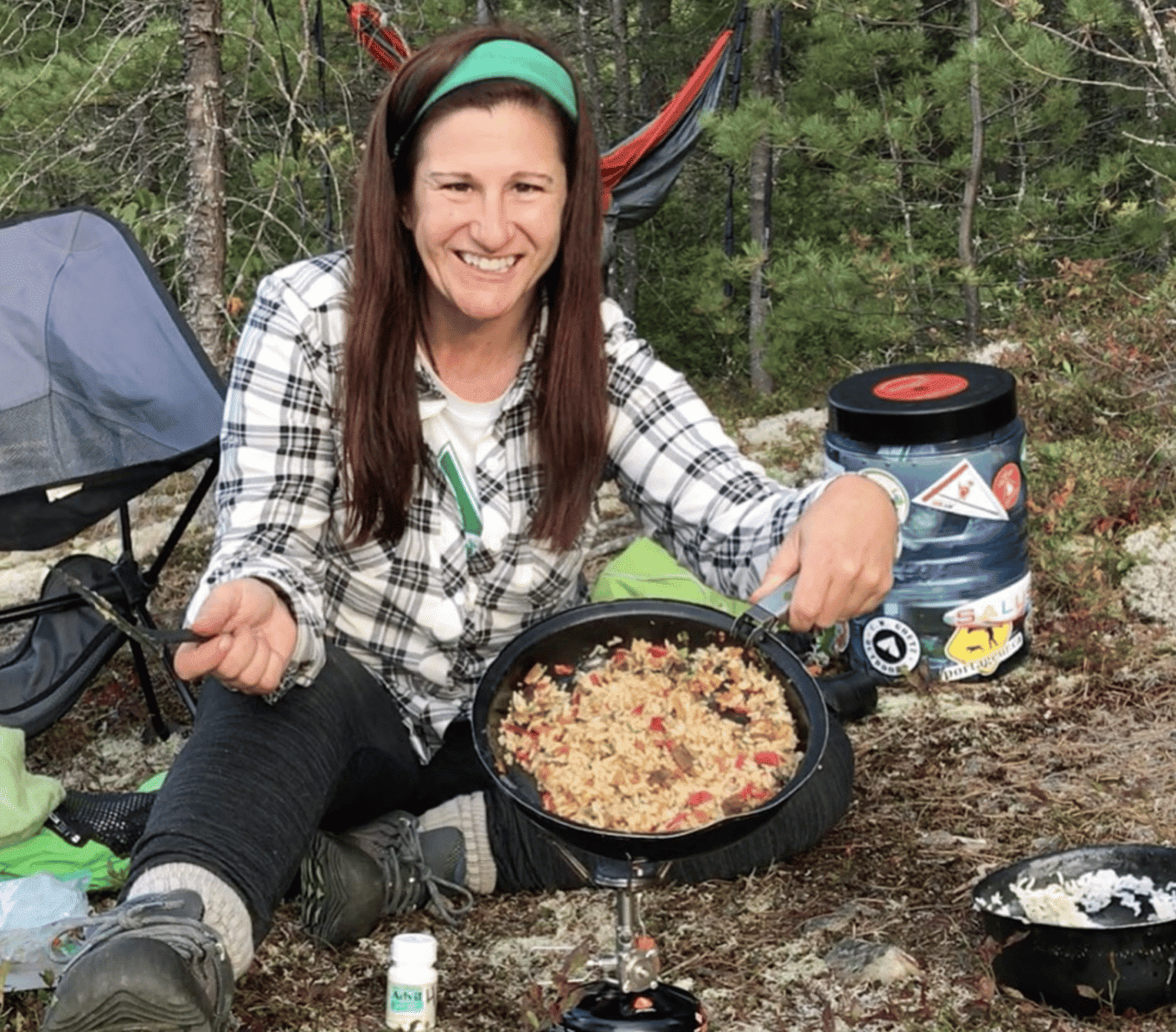
Sleeping in the Rain
If you pitch your tent right, sleeping in the rain won’t be a problem. You chose high ground, staked down your rain fly nice and taught, and kept your gear dry while you did it. All of that equates to the ability to slip into a nice, dry sleeping bag to recover from all those miles you put in.
Picking a good tent spot is important in the rain. What seems like a nice flat spot may become a very large puddle when the rain comes. Furthermore, do not choose a tent spot where you will need to dig channels to redirect water away from your tent. This really disturbs the landscape.
But even the best planning can’t always outsmart Nature. What do you do if you wake up to water dripping on your nose? Or you find pooling inside your tent?
The next steps will depend largely on your goals for the day and the trip. How important is comfort? Would you rather pack up your wet gear, travel first, and dry it out later? Is there more rain in the forecast? Is the temperature low enough to make being wet dangerous?
There are a lot of factors that go into making a decision when all your prep and planning fail to keep you or your gear dry.
If you’re on a short weekend excursion, you may decide to just call it quits and head home to dry out and recoup the fun factor in a different way. If you’re in the middle of the Appalachian Trail and the sun is supposed to shine soon, you could get some miles in while it’s still raining and set up camp to dry out.
When Wet Becomes Dangerous
If the temperature is high enough, being wet isn’t really a problem, per se. There’s the clothing sticking to your skin, water dripping into your eyes, the hassle of pitching a tent in the rain… but as long as you’re warm enough, it’s just another backpacking discomfort to grin and bear.
But a dip in the temperature makes being wet actually dangerous.
Hypothermia can occur in temperatures well above freezing. Even dry conditions that hang out in the 40s for an extended period of time can result in a drop in your body temperature, especially if you’ve layered up enough to cause sweating. But if you get wet in a surprise downpour and it’s anywhere close to 40 degrees, you need to be cautious.
Submersion in water causes heat loss at a rate that’s 25 times faster than the same temperature of dry air.
Pay close attention to your body and take any warning signs seriously. Drowsiness, confusion, uncontrollable shivering, and any weakness or loss of coordination are signs that your core temperature is dropping.
Getting dry is your top priority. Set up camp as quickly as possible. When your tent is up, take off your wet clothes before entering. Crawling into your dry sleeping bag sans clothes will bring you back to a safe temperature.
But what if it doesn’t?
Some people have a hard time regulating their body temperatures. Conditions like hypothyroidism, circulatory issues, and other medical concerns can make it difficult to generate your own body heat. Heating water and putting it in an uninsulated water bottle can help increase the temperature inside your sleeping bag. Flexing your muscles can also create energy, which creates heat.
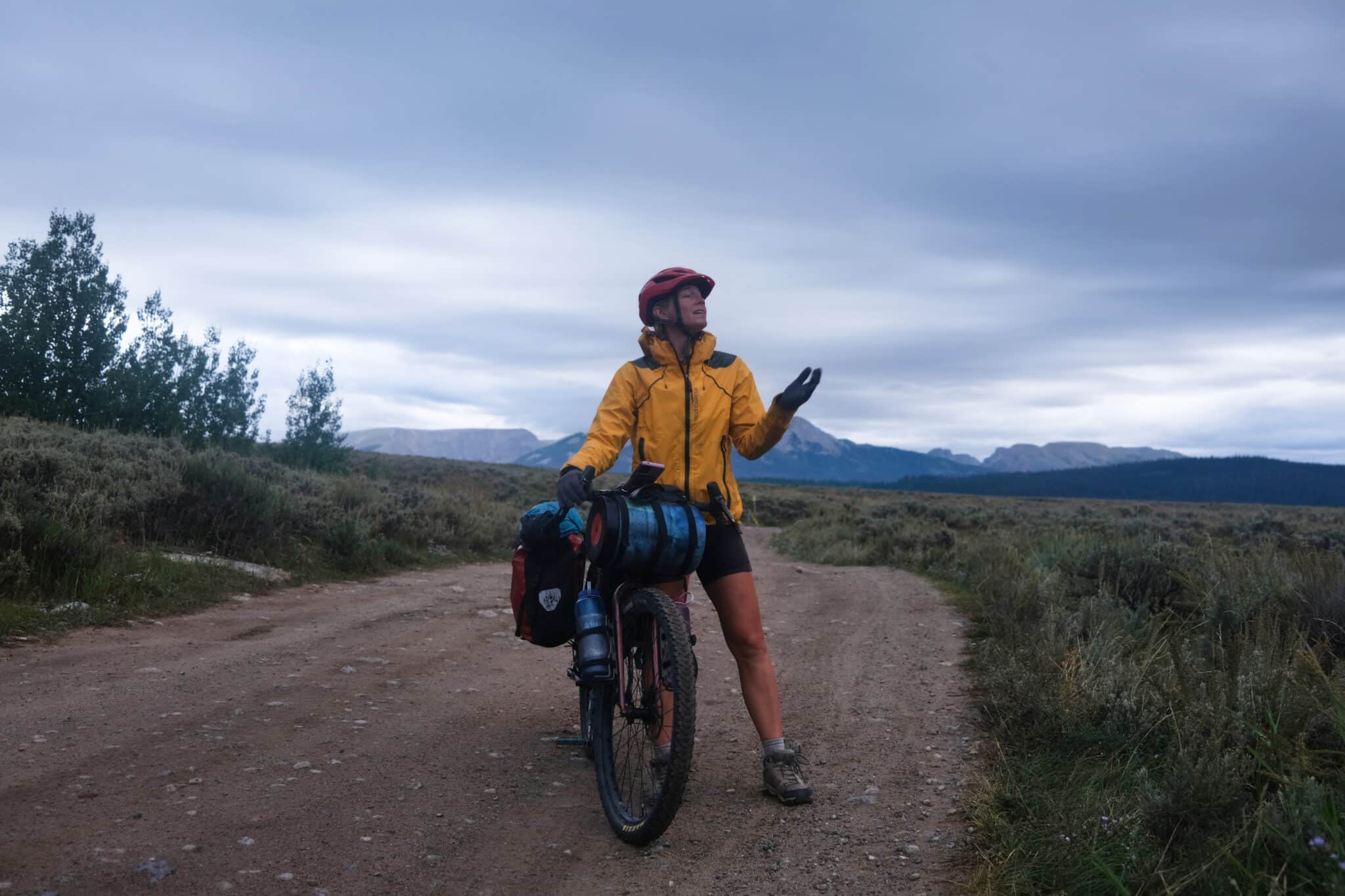
No Bad Weather
It was originally a man named Alfred Wainwright who coined the phrase, “There’s no such thing as bad weather; just unsuitable clothing.” But it was a rosy outlook on life and undying love for walking outside that made his 1960s outdoor apparel weather-resistant. “One can forget even a raging toothache on Haystacks,” he wrote.
I tend to agree. After all… when your eyes are full of Nature’s beauty, no amount of discomfort makes it not worth the effort. But appropriate gear for the weather we experience can sure make that trip more fun.
Author Profile

Jessica Cockroft
Jess merges her passion for words and an insatiable longing for adventure as an outdoor freelance content writer and marketer. When she’s not busy stringing words together you’ll probably find her planning another camping trip for her crew of kids or taking care of the homestead. You can find her on LinkedIn and Instagram, as well as on her own website.

